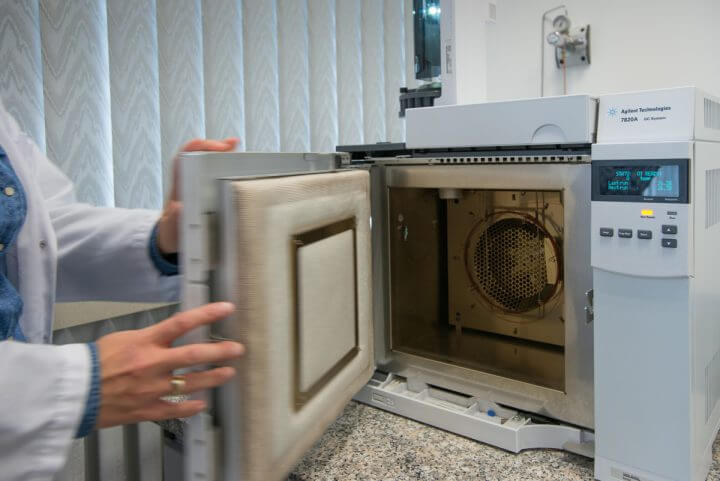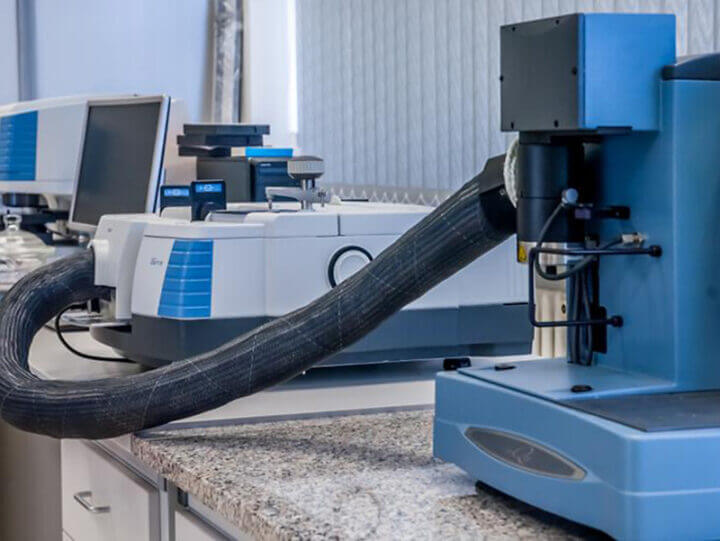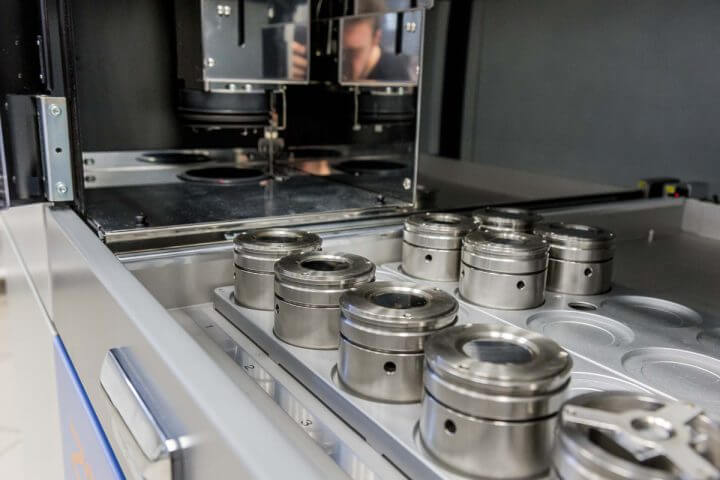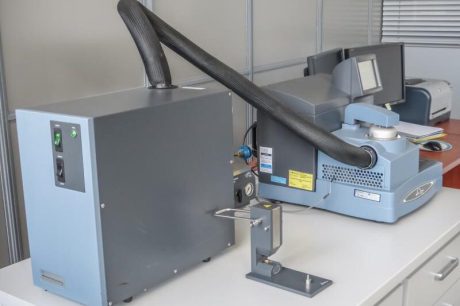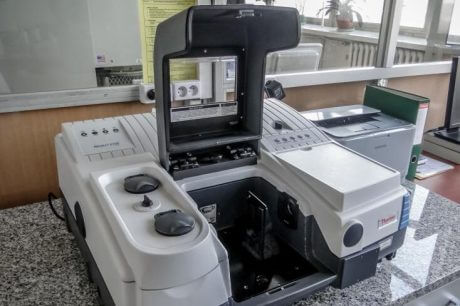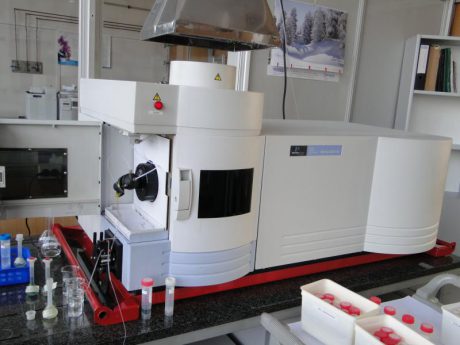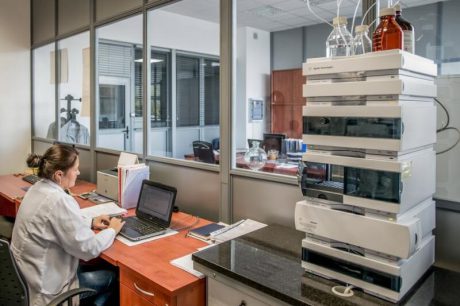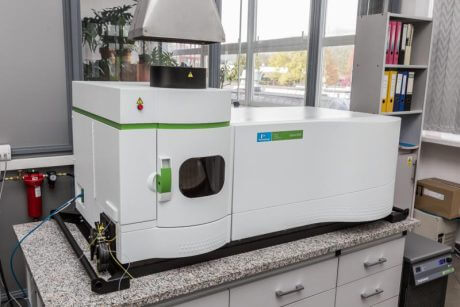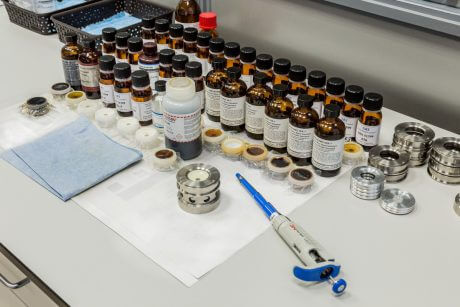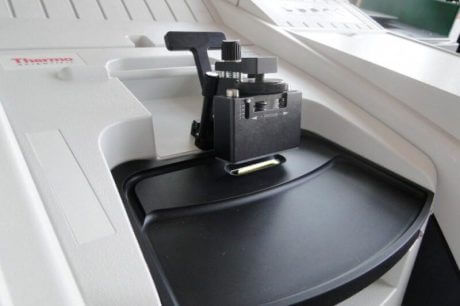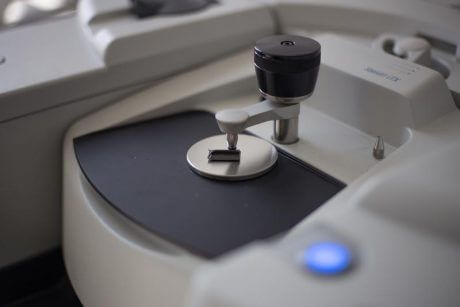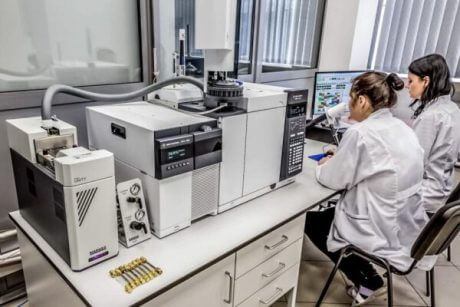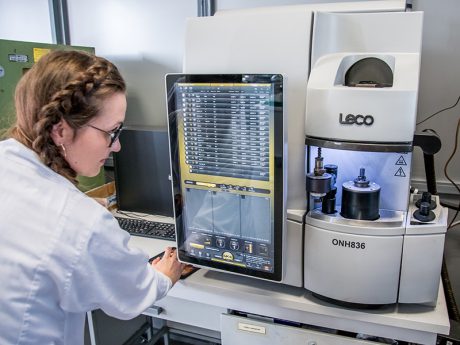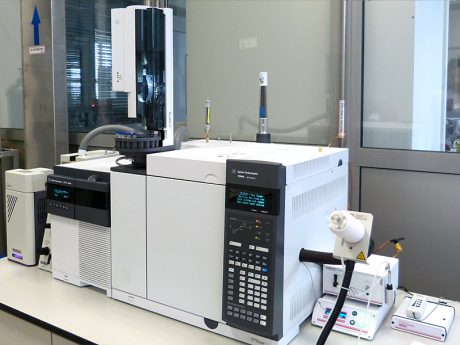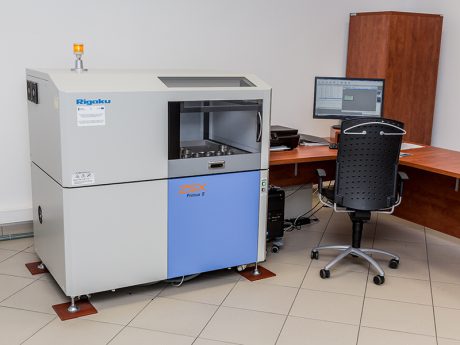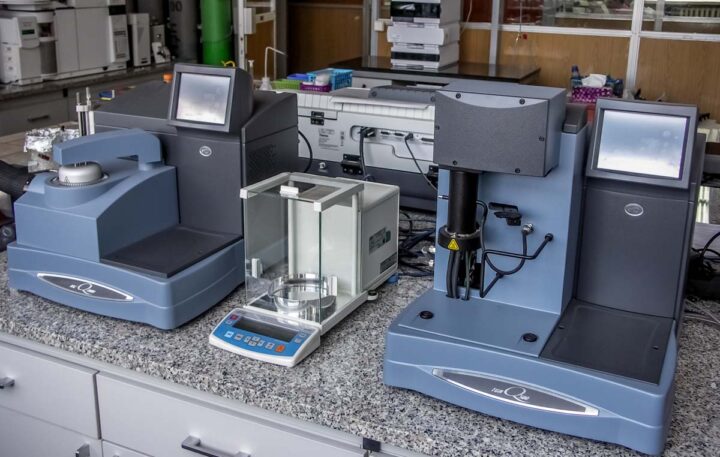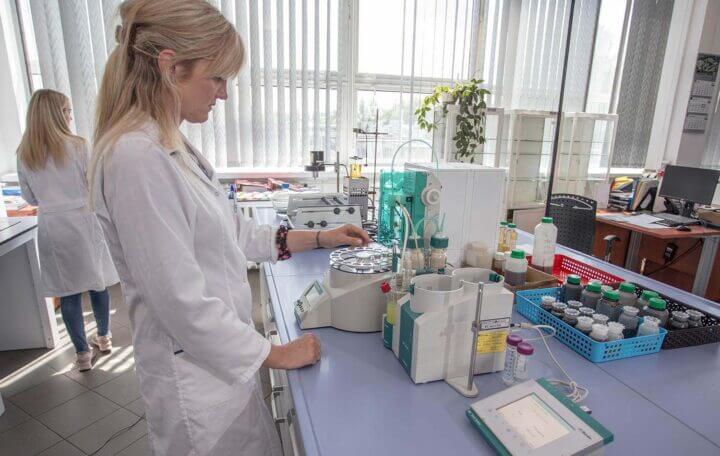On this page:
Identification of products’ materials and contamination, chemical composition

Identification of products’ materials and contamination
In the case of metals and their alloys, identification is based on inductively coupled plasma optical emission spectrometry (ICP-OES) and X-ray fluorescence with wavelength dispersion (WD-XRF) methods. Use of additional techniques such as Fourier transformation infrared spectroscopy (FTIR) and chromatography allows identification of substances located on the surface of the tested material, and determination of whether those substances’ presence is deliberate or is the result of contamination.
In the case of plastics and rubbers, identification is based mainly on analysis via the Fourier transformation infrared spectroscopy (FTIR) method. Spectrograms obtained from the test material are analysed for the presence of characteristic signals; the results of the identification are referenced against an extensive database of various materials’ spectrograms. Additionally, the identification is supported by tests using differential scanning calorimetry (DSC) and thermogravimetric (TGA) methods. Analysis of gases emitted at elevated temperatures using chromatographic methods and as a result of thermal decomposition using thermogravimetry coupled with infrared spectrometry with Fourier transformation method (TGA-FTIR) is possible.
In the case of petroleum products, identification is based on Fourier transformation infrared spectrometry (FTIR), chromatographic methods and emission spectrometry and X-ray fluorescence. Those methods facilitate – among other things – the differentiation of engine oils and fuels with and without biocomponents, determination of the elemental content of additive packages and tests of petroleum products for analysis of the causes of failures in systems in which those products are used.
Equipment
- infrared spectrometer with Fourier transformation (FTIR) – spectrometer allowing the analysis of substances using single (ATR) and multi-reflection (HATR) transmission techniques
- infrared spectrometer with Fourier transformation (FTIR) – spectrometer allowing the analysis of substances using single (ATR) and multi-reflection (HATR) transmission techniques
- thermogravimetric analyser (TGA)
- differential scanning calorimeter (DSC)
- optical emission spectrometer with inductively coupled plasma (ICP-OES)
- optical emission spectrometer with inductively coupled plasma (ICP-OES)
- x-ray fluorescent spectrometer with wavelength dispersion (WD-XRF)
- gas chromatograph with flame ionization and mass spectrometer (GC-FID/MS)
- gas chromatograph with flame ionization detector (GC-FID)
- gas chromatograph with nitrogen-phosphorus and mass detector (GC-NPD/MS) and sniffer port
- Infinity High performance liquid chromatograph
Testing norms
Material identification is based on in-house testing instructions, for example: BOSMAL/I-7-41, BOSMAL/I-7-43, BOSMAL/I-7-90 and Polish and international material and product norms.
Analysis of emitted gas (evolved gas analysis – EGA)
Simultaneous coupled techniques include sample testing using two (or more) instrumental techniques. Such techniques include coupled thermogravimetry with infrared spectrometry with Fourier transformation (TGA-FTIR), which allow testing of outgassing during thermal degradation. The test sample is heated up at a constant rate, according to a controlled temperature change program and the mass change is measured as a function of the temperature, simultaneously analysing the gas emitted during the thermogravimetric analysis. Alternatively, the sample is kept at a specified, constant temperature, measuring the mass change as a function of time within a specified timeframe, together with simultaneous analysis of emitted gaseous products. The final stage of the measurement is IR spectrum interpretation, from which information about the functional groups and the type of bonds which were present in test gas sample emitted from the degradable material at a given temperature or within a given timeframe is obtained.
Equipment
- The laboratory possesses a thermogravimetric analyser:
- equipped with a quartz stove for EGA analysis;
- equipment temperature range: from RT to 1000°C;
- controlled heating speed: from 0.1 to 100°C/min;
- Coupled FTIR spectrometer
Testing norm
- BOSMAL/I-7-95
Chemical composition tests – elemental composition
We conduct chemical composition tests (determining the content of main and trace elements) of different types and on samples of diverse origin, among others:
- metals, metal alloys and sinters, among others: iron alloys, cast iron, aluminium and aluminium alloys, copper and copper alloys, zinc and zinc alloys, nickel and nickel alloys and others
- dusts, sediments, residues, liquid and solid samples of various origin, water
- petroleum products, including fuels (gasoline, diesel, biodiesel and others), biocomponents, engine oils, transmission oils, lubricants, cooling fluids and others
- plastic, rubber, fabrics, textiles, foams, etc.
- anti-corrosion coatings
Tests are conducted according to BOSMAL’s validated in-house testing instructions and methods described in norms.
Norms
- Metal testing according to in-house testing instructions: BOSMAL/I-7-43, BOSMAL/I-7-90 and in accordance with PN-EN ISO 9556, PN-EN 24935, PN-EN ISO 10720
- ROHS directive compatibility tests – determination of heavy metal content: Cd, Pb, Hg, Cr VI and total Br content, according to in-house testing instructions BOSMAL/I-7-43, BOSMAL/I-7-90
- chromium coatings – determination of Cr VI content according to PN-EN ISO 3613
- elemental content – including sulphur – in fuels, liquid biofuels, biocomponents and engine oils
- PN-EN 14538, PN-EN 16136, PN-EN 16294, PN-EN 16476, PN-EN 15944, PN-EN 14107, PN-EN 16576, PN-EN ISO 14596, PN-EN ISO 14597, PN-EN 15485, PN-EN ISO 20884, PN-V-04030, ASTM D7111, ASTM D5708, ASTM D5185, ASTM D4951, ASTM D4927, ASTM D6443, DIN 51399-1
- and others
Apparatus
Latest-generation spectrometers are used for testing:
- Inductively Coupled Plasma Optical Emission Spectrometer (ICP-OES)
- Inductively Coupled Plasma Optical Emission Spectrometer (ICP-OES)
- wavelength dispersion X-ray fluorescence spectrometer (WD-XRF)
- carbon and sulphur analyser
- nitrogen analyzer
- spectrometer
We possess a very well-equipped laboratory for preparation of testing samples (with microwave mineralisers, ultrasonic baths, grinding and polishing machines, etc.)
Soot content
Heating of the test sample at a stable rate, according to a controlled temperature change programme causes sample weight change through decomposition, oxidation reactions or emission of certain components. As a result, the method allows mass changes as a function temperature to be measured.
Equipment
- The laboratory features the following thermogravimetric analyzer:
- equipped with a quartz furnace for EGA analyses
- device working temperature range from RT to 1000°C
- controlled heating speed: from 0.1 to 100°C/min
Testing norms
- PN-EN ISO 11358
- ISO 9924-1
- ISO 9924-2
- ASTM D6370
- ASTM E1131
Client norms
- VW, PSA, Mercedes, others
Water content
Plastic can accumulate water in several ways. Three types of moisture are relevant: surface moisture, capillary moisture and molecular moisture. Most materials have hygroscopic properties (ABS, PC, PA, PET) and water can penetrate into them, both in the case of granules and panels or fittings. From the material processing technological point of view, moisture is most dangerous where processing at higher temperatures is conducted – thus in virtually every type of plastic technology. In our materials science laboratory, water content is determined using a weighing-drying method based on in-house procedure BOSMAL/I-7-49/05.
Absorbency (absorbability) can also be determined for the aforementioned materials. Strongly absorbent materials featuring polar groups, for example: cellulose, phenolic polymers, aminoplastics and polyamides. Water absorbency expressed in units of weight percentage is called weight absorbency and is defined as the ratio of the mass of water absorbed by the sample to the mass of the dry sample. Polymer materials’ absorbency (absorbability) tests are conducted in the laboratory using climatic chambers according to the norm PN-EN ISO 62:2008, p. 6.3, 6.4, 6.6 Equipment. The laboratory includes a number of dryers, vacuum dryers and analytic scales.
Testing norms
- Instruction: BOSMAL/I-7-49
- PN-EN ISO 62 p. 6.3, 6.4, 6.6
Client norms
- • Ford, Mercedes, Kia, Fiat, others
Apparatus for the determination of water by the Karl Fischer method
This device enables the determination of water content by volumetric and coulometric methods, at any concentration level (ppm/%). It allows the determination of water content in samples of:
- plastics,
- rubbers,
- composites,
- lubricants,
- petroleum products,
- paints,
- adhesives, etc.
For insoluble and slow water-releasing samples, it is possible to use the oven method (temperature range 50-250°C), with the possibility of introducing a gas flow (10-150 mL/min; N2, dried air, or another gas).
- PN-EN 14538 – Oil and fat processing products – Fatty acid methyl esters (FAME) – Determination of Ca, K, Mg and Na content by inductively coupled plasma optical emission spectrometry (ICP OES)
- PN-EN 16136 – Automotive fuels. Determination of manganese and iron content in unleaded petrol. Inductively coupled plasma optical emission spectrometry (ICP OES) method.
- PN-EN 16294 – Petroleum products and fat and oil derivatives. Determination of phosphorus content in fatty acid methyl esters (FAME). Optical emission spectral analysis with inductively coupled plasma (ICP OES).
- PN-EN 16476 – Liquid petroleum products – Determination of Sodium, Potassium, Calcium, Phosphorus, Copper and Zinc contents in diesel fuel – Method via Inductively Coupled Plasma Optical Emission Spectrometry (ICP OES)
- PN-EN 15944 – Liquid petroleum products. Determination of nickel and vanadium content. Inductively coupled plasma optical emission spectrometry method (ICP OES)
- PN-EN 14107 – Fat and oil derivatives. Fatty acid methyl esters (FAME). Determination of phosphorous content by inductively coupled plasma (ICP) emission spectrometry
- PN-EN 16576 – Automotive fuels. Determination of manganese and iron content in diesel. Inductively coupled plasma optical emission spectrometry (ICP OES) method
- PN-EN ISO 14596 – Petroleum products – Determination of sulfur content – Wavelength-dispersive X-ray fluorescence spectrometry
- PN-EN ISO 14597 – Regulators and limiters of temperature in heat generation systems
- PN-EN 15485 – Ethanol as a blending component for petrol. Determination of sulfur content. Wavelength dispersive X-ray fluorescence spectrometric method
- PN-EN ISO 20884 – Petroleum products – Determination of sulfur content of automotive fuels – Wavelength-dispersive X-ray fluorescence spectrometry
- PN-V-04030 – Petroleum products – Determination of the content of elements in liquid fuels and similar products by atomic emission spectrometry with inductively induced plasma
- ASTM D7111 – Standard Test Method for Determination of Trace Elements in Middle Distillate Fuels by Inductively Coupled Plasma Atomic Emission Spectrometry (ICP-AES)
- ASTM D5708 – Standard Test Methods for Determination of Nickel, Vanadium, and Iron in Crude Oils and Residual Fuels by Inductively Coupled Plasma (ICP) Atomic Emission Spectrometry
- ASTM D5185 – Determination of Additive Elements, Wear Metals, and Contaminants in Used Lubricating Oils and Determination of Selected Elements in Base Oils by ICP-OES
- ASTM D4951 – Standard Test Method for Determination of Additive Elements in Lubricating Oils by Inductively Coupled Plasma Atomic Emission Spectrometry
- ASTM D4927 – Standard Test Methods for Elemental Analysis of Lubricant and Additive Components – Barium, Calcium, Phosphorus, Sulfur, and Zinc by Wavelength-Dispersive X-Ray Fluorescence Spectroscopy
- ASTM D6443 – Standard Test Method for Determination of Calcium, Chlorine, Copper, Magnesium, Phosphorus, Sulfur, and Zinc in Unused Lubricating Oils and Additives by Wavelength Dispersive X-ray Fluorescence Spectrometry (Mathematical Correction Procedure)
- DIN 51399-1 – Testing of lubricants – Determination of elements content in additives, wear and other contaminations – Part 1: Direct determination by optical emission spectral analysis with inductively coupled plasma (ICP OES)
- PN-EN ISO 11358-1 – Plastics – Thermogravimetry (TG) of polymers – Part 1: General principles
- ISO 9924-1 – Rubber and rubber products – Determination of the composition of vulcanizates and uncured compounds by thermogravimetry – Part 1: Butadiene, ethylene-propylene copolymer and terpolymer, isobutene-isoprene, isoprene and styrene-butadiene rubbers
- ISO 9924-2 – Rubber and rubber products – Determination of the composition of vulcanizates and uncured compounds by thermogravimetry – Part 2: Acrylonitrile-butadiene and halobutyl rubbers
- ASTM D6370 – Standard Test Method for Rubber – Compositional Analysis by Thermogravimetry (TGA)
- ASTM E1131 – Standard Test Method for Compositional Analysis by Thermogravimetry
- BOSMAL/I-7-49 – Determination of the content of volatile substances (including water) in plastics by the dryer-weight method
- PN-EN ISO 62 – Plastics – Determination of water absorption
- BOSMAL/I-7-95 – BOSMAL/I-7-95
- PN-EN ISO 15512 – Plastics — Determination of water content
Back
to top


